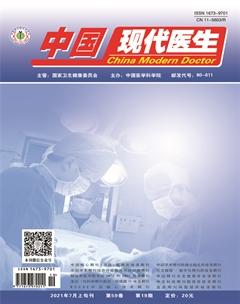肝硬化合并肾损害的危险因素分析
陆秀伟 杨娟



[关键词] 肝硬化;肾损伤;危险因素;腹水;肝性脑病;高血压;糖尿病
[中图分类号] R657.31 [文献标识码] B [文章编号] 1673-9701(2021)19-0096-04
Analysis on the risk factors of cirrhosis combined with renal damage
LU Xiuwei YANG Juan
Department of Hepatology, Xixi Hospital of Hangzhou City, Hangzhou 310023, China
[Abstract] Objective To investigate the risk factors of cirrhosis combined with renal damage. Methods The clinical data of 100 patients with hepatic cirrhosis diagnosed and treated in our hospital from January 2017 to December 2019 were selected for the study. According to whether the patients had renal damage, they were divided into the renal damage group and the no renal damage group. The general data of the patients, complications, ascites condition, hepatic encephalopathy condition and others were recorded, and the risk factors for hepatic cirrhosis combined with renal damage were analyzed by univariate and multivariate analysis. Results Univariate analysis showed that patients with aged≥60 years, CTP grade C, complications of hypertension, diabetes, hyperuricemia, exposure history of contrast media, and hepatic encephalopathy had a higher probability of renal damage(P<0.05). Multivariate analysis showed that patients with age≥60 years, CTP grade C, complications of hypertension, diabetes, hyperuricemia, and PVD>12.5 mm were the independent risk factors for patients with hepatic cirrhosis complicated with renal damage(P<0.05). Conclusion Renal damage may occur in patients with hepatic cirrhosis. Age, CTP grade C, complications of hypertension, diabetes, hyperuricemia, and PVD widening are the independent risk factors for patients with hepatic cirrhosis complicated with renal damage.
[Key words] Hepatic cirrhosis; Renal damage; Risk factors; Ascites; Hepatic encephalopathy; Hypertension; Diabetes
肝硬化是由不同原因引起的慢性、进行性、弥漫性肝脏病变,主要病理變化为肝细胞广泛坏死,在此基础上出现纤维组织弥漫性增生。在肝失代偿期,除了肝功能减退,还会出现消化道症状,如出血、贫血、内分泌失调、感染、肝性脑病、电解质紊乱等。而肝硬化性肾损害是常见的并发症之一,主要表现为肾小球病变、肾小管酸中毒,严重者出现肝肾综合征,此外,肝炎后肝硬化患者常可呈现乙肝或丙肝相关性肾炎的表现,如膜增殖性肾炎、膜性肾病、毛细血管内增生性肾炎、肾小球硬化等[1-2]。本研究旨在探讨肝硬化患者发生肾损害的相关因素,以期为临床值提供参考,现报道如下。
1 资料与方法
1.1 一般资料
选择2017年1月至2019年12月我院诊断治疗的肝硬化患者100例的临床资料进行研究。纳入标准:年龄≥18周岁,符合肝硬化诊断标准[3],合并或未合并肾脏损害,临床资料完整,患者及其家属对本研究知情同意。排除标准[3]:急性肾脏原发性疾病或继发于其他疾病的肾脏疾病者;合并有免疫系统疾病者;认知功能障碍者;近期应用糖皮质激素者;妊娠期或哺乳期者。患者一般资料见表1。本研究经医院医学伦理委员会同意。
1.2 方法
1.2.1 记录指标 ①CTP分级[4]:根据患者白蛋白、凝血酶原时间、血清总胆红素水平进行评分,5~6分为A级,7~9分为B级,≥10分为C级,级数越高表示患者病情越重。②肾功能评价[4]:计算患者eGFR,<60 mL/(min·1.73 m2)为存在肾损害。③记录患者年龄、性别、既往病史(高血压、糖尿病、泌尿系结石、高尿酸血症)、是否应用造影剂史,记录入院时患者病情、门静脉主干内径(PVD)、是否合并腹水、是否合并肝性脑病。

